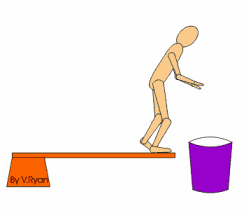|
|
Springs are available in a large variety of shapes and sizes. Almost everyone will have either used a springboard at a swimming pool to dive into the water. The springboard may be made from laminated wood (layers of wood glued together) or be a more modern glass fibre type material. The result is the same - the diver uses his/her weight to spring off the board into the air. Springs have a very wide range of uses and it is difficult think of a mechanical device without one or more of them. |
|
Springs perform different actions and some examples are seen below. Some restrict stretching whilst others restrict compression. |
|
|
|
 |
|
SPRING RESISTING STRETCHING |
SPRING RESISTING COMPRESSION |
|
|
Look at the examples of springs. Can you think of any real mechanisms that includes springs like these? If so, draw them and explain how they are used. |
|
SPRING THAT RESISTS TWISTING |
|
|
|
| Springs are used in
engines, motors, watches, clocks, door handles, locks, pens etc...
Choose a simple mechanism and dismantle it. Study how any springs work and draw diagrams to represent the movement involved (add explanatory notes). List some materials that have 'spring' in them (example - a plastic ruler). |
|
|
|
|


